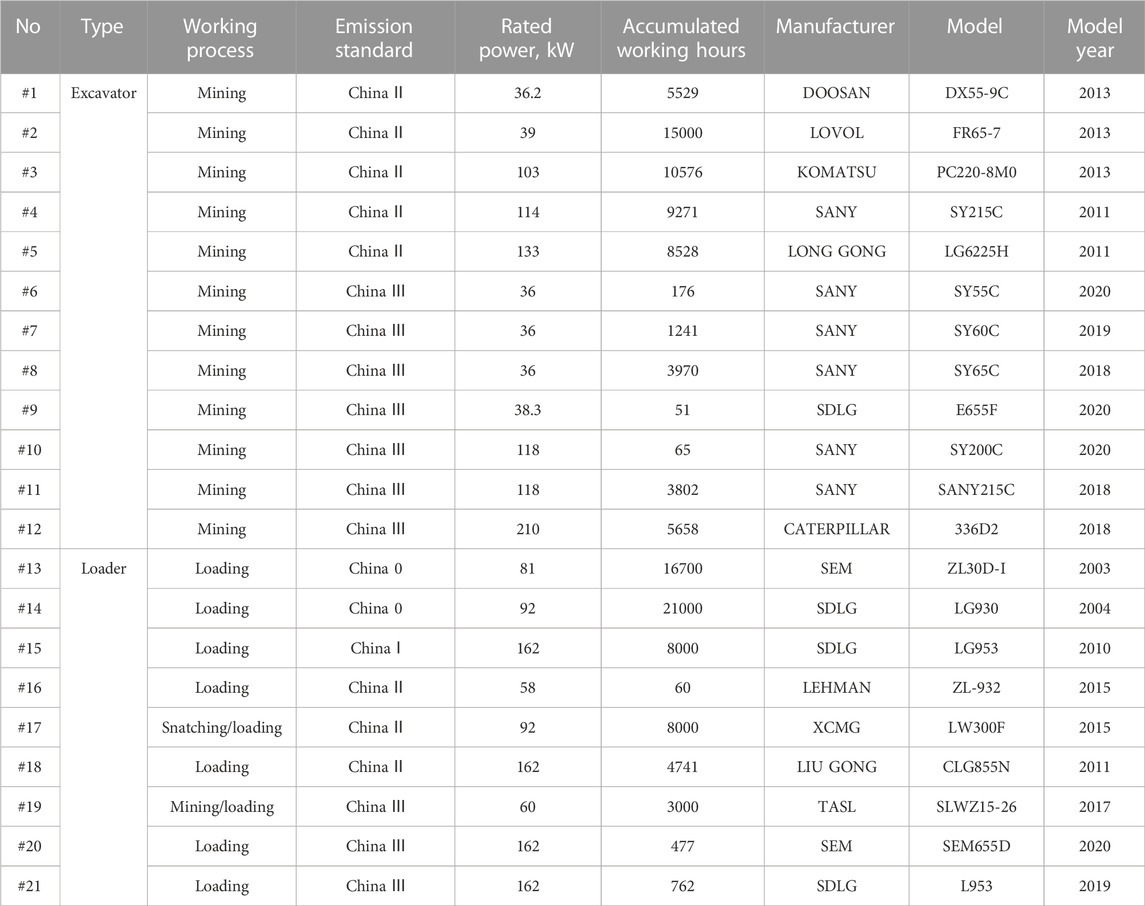- 1School of Ecology and Environment, Beijing Technology and Business University, Beijing, China
- 2State Environmental Protection Key Laboratory of Food Chain Pollution Control, Beijing Technology and Business University, Beijing, China
- 3Key Laboratory of Cleaner Production and Integrated Resource Utilization of China National Light Industry, Beijing Technology and Business University, Beijing, China
1 Introduction
There are serious air pollution problems in Chinese cities, which are manifested as high levels of ground ozone (O3) and particulate matter (PM) with an aerodynamic diameter of 2.5 μm or smaller (PM2.5) (Dong et al., 2014). Carbonyl compounds are a class of oxygen-containing volatile organic compounds that are important precursors of the formation of O3 and secondary organic aerosols (SOAs), these compounds can contribute 17%–50% to the ozone formation potential (OFP) (Duan et al., 2008; Han et al., 2019), and they can lead to the generation of photochemical smog (Shen et al., 2013; Zhang et al., 2019; Shen H. et al., 2021). Carbonyl compounds include aldehydes, ketones and dicarbonyl compounds, which are harmful to human health. Formaldehyde and acetaldehyde have been identified as toxic air pollutants and can generate carcinogenic effects (World Health Organization, 2000). Formaldehyde can irritate the upper respiratory tract and can affect health after acute or chronic exposure through inhalation and other forms of exposure, including through the eyes, nasopharynx and throat. Formaldehyde was included in the first list of human carcinogens by the International Agency for Research on Cancer (Cogliano et al., 2011; Luecken et al., 2018). Acetaldehyde can cause digestive tract diseases (Ho et al., 2015), and acrolein can damage the cardiovascular system and cause cardiomyopathy and heart failure (Henning et al., 2017).
The main sources of atmospheric carbonyl compounds are anthropogenic, natural and atmospheric photochemical reactions (Christensen et al., 2000; Ho et al., 2002), the anthropogenic sources include vehicle exhaust, biomass combustion, industrial processes, interior decoration procedures and cooking activities (Tsai et al., 2012; Yao et al., 2015a, Yao et al., 2015b; Seco et al., 2007; Sindelanova et al., 2014). The carbonyl compounds emitted by motor vehicles in urban areas cannot be ignored, which has attracted increasing attention among researchers. The bench test, tunnel test and onboard test methods have mainly been used to evaluate gasoline and diesel vehicle emissions containing carbonyl compounds. Schauer et al. (1999) and Caplain et al. (2006) used a dynamometer to determine the carbonyl emissions of gasoline and diesel vehicles, respectively, meeting Euro III emission standards. Pierson et al. (1996) and Ban Weiss et al. (2008) quantified the carbonyl compound emission rate of light and heavy vehicles in the Fort McHenry Tunnel and Bay Area Highway Tunnel, United States, respectively; Ho et al. (2007), Zhang et al. (2016) and Wu et al. (2021) obtained the emission factors (EFs) for carbonyl compounds of gasoline, diesel and liquefied petroleum gas (LPG) vehicles, respectively, in the Chengmen Tunnel and Pearl River Tunnel in China; Nogueira et al. (2015) obtained carbonyl emission data of light-duty vehicles (LDVs) and heavy-duty vehicles (HDVs) in a traffic tunnel in the Sao Paulo metropolitan area of Brazil. However, the tunnel test method measures mean EFs and total emissions but cannot measure the EF of an individual vehicle. The chassis dynamometer test method measures the EF of an individual vehicle but cannot measure on-road real-time emissions (Shen et al., 2014; Shen et al., 2021d). A portable emission measurement system (PEMS) can measure vehicle on-road real-time emissions and is usually employed to measure vehicle carbonyl compound emissions. Yao et al. (2015a), Yao et al. (2015b), Yao et al. (2015c) and Cao et al. (2016, 2020) used a PEMS to determine the carbonyl compound emissions of gasoline and diesel trucks in Beijing and Xiamen, respectively. The average EF of gasoline vehicles was 58.67 mg/(kg-fuel), the average light-duty diesel truck (LDDT) EF was 137.74 mg/(kg-fuel), the average medium-duty diesel truck (MDDT) EF was 175 mg/(kg-fuel), and the average heavy-duty diesel truck (HDDT) EF was 309.38 mg/(kg-fuel). With the development of testing technology, PEMS have been used to test the emission of CO, HC, NOX, PM and its components, PN, BC and other pollutants from non-road mobile machinery (Fu et al., 2012; Cao et al., 2016; Li et al., 2021; Pang et al., 2021; Yu et al., 2020; Zhang et al., 2020; Tan et al., 2021; Wu et al., 2022a; Wu et al., 2022b; Shen et al., 2023). Fu et al. (2012) performed tests on twelve excavators and eight loaders under real-world operating conditions by using a PEMS to determine their gaseous and PM emission characteristics. Zhang et al. (2020) conducted real-world measurements on three typical types of NRCE to study their emission characteristics and chemical composition of PM by a PEMS. Tan et al. (2021) performed real-world measurements on 16 excavators and 19 loaders by using a PEMS to quantify CO, HC, NOx and particle number (PN) EFs under idling, moving and working modes. Wu et al. (2022a) and Wu et al. (2022b) investigated the multi-pollutant (CO, HC, NOx, PM2.5, and BC) and CO2 emissions from non-road construction equipment under real-world conditions by using a PEMS.
With the increasingly strict control of urban motor vehicles, the contribution of construction machinery emissions to carbonyl compounds in urban areas is becoming increasingly important. In 2020, the total amount of hydrocarbons (HCs) emanating from non-road mobile sources was 4.25 × 105 tons, and the emissions of construction machinery accounted for 28.2% of the total emissions (MEE, 2021), which constitutes the second largest pollution source among non-road mobile sources (Shen et al., 2021b). There exists a strong positive correlation between the total emissions of non-road machinery and the urbanization level (Fan et al., 2018; Guo et al., 2020; Fan et al., 2023). The total amount of self-owned construction machinery equipment reached 9.83 × 106 by the end of 2020. Construction machinery, including excavators, loaders, and bulldozers, are widely used in construction, water conservancy, electric power, roads, national defense and other engineering fields.
However, construction machinery usually exhibit a high workload, long service life and lack of maintenance (Fu et al., 2012). The regulation and control procedures of non-road mobile machinery generally lag behind those of road vehicles (Bie et al., 2022). At present, research on the emissions of construction machinery mainly adopts the chassis dynamometer and PEMS to study CO, HC, NOX, PM and its components, PN, BC and other pollutants (Frey et al., 2008, Frey et al., 2010; Cao et al., 2018; Ma et al., 2018; Zhang et al., 2020; Tan et al., 2021; Tu et al., 2021). However, carbonyl compound emissions from construction machinery using PEMS have been studied little. Real-world carbonyl compound emissions from construction machinery are still not understood. Yao et al. (2015c) and Yu et al. (2023) measured the emission of carbonyl compounds from rural vehicles and agricultural machines in China using PEMS and found that severe carbonyl compound pollution was caused by agricultural machines.
The main purpose of this study was to better understand the emission characteristics of carbonyl compounds in the actual working process of construction machinery in China. Twenty-one construction machinery types meeting different emission standards in various working processes were evaluated via a PEMS in China. Carbonyl compounds were collected using a 2,4-dinitrophenylhydrazine (2,4-DNPH) adsorption cartridge and then qualitatively and quantitatively determined via high-performance liquid chromatography (HPLC). The carbonyl compound fuel-based EF was calculated, the influence of emission standards, working processes and machinery type on the carbonyl compound emissions of construction machinery was characterized, and the OFP of the tested construction machinery was obtained. The research results can improve our understanding of the potential impact of construction machinery on ozone formation, improve the accuracy of construction machinery emission inventories, help decision makers develop more effective tailpipe emission control measures to improve air quality.
2 Materials and methods
2.1 Sampling system and fleet
In this test, PEMS equipment was used to measure the carbonyl compound emissions of construction machinery under real-world working conditions. The exhaust gas originating from the exhaust pipe passed through four parts: a SEMTECH-LDV gas analyzer (Sensors, Ann Arbor, MI, United States), SEMTECH-EFM exhaust flowmeter (Sensors, Ann Arbor, MI, United States), CTM-039 fine particulate matter (FPM) isokinetic sampling dilution system (Environmental Supply Company, Durham, NC, United States) and carbonyl compound sampling device. A fixed dilution ratio model is used for a single test. The dilution ratio was adjusted appropriately according to the test object, the dilution ratio was 12.6 ± 3.1 (Average ± Standard deviation) for construction machinery 1# to 7#, the dilution ratio was 8.0 ± 0.5 for construction machinery 8# to 21#. The carbonyl compound sampling unit comprised a rotameter, a three-stage sampling cylinder and a nonoil pump in series. Two 2,4-DNPH adsorption columns were connected in series downstream of the KI sampling cylinder to eliminate any interference of oxides and particles for penetration prevention. The using two DNPH adsorption columns is to prevent one DNPH adsorption column from being penetrated. Aldehydes and ketones in the emitted tail gas were collected in the system by reacting with 2,4-DNPH. Two DNPH adsorption columns were separately eluted with acetonitrile, and the eluate was diluted to 5 ml. The target compounds were analyzed via HPLC. The mobile phase was water and acetonitrile. The gradient elution procedure is summarized in the table, in which the injection volume was 20 μL, the flow rate was 1 ml/min, the column temperature was 25°C, and the wavelength of the UV detector was 360 nm. Detailed information is provided in our previous study (Shen et al., 2021c; Yu et al., 2023).
The sampling process in this experiment was conducted in Jining city, Shandong Province. A total of 21 construction machineries were assessed, including 9 loaders and 12 crawler hydraulic excavators. The machines tested in this study were produced from 2003 to 2020. Two machines met the China 0 (C0) standard (before the implementation of the China I standard (CI)), one machine met the CI standard, eight machines met the China Ⅱ standard (CII) and ten machines met the China Ⅲ standard (CIII). The test included walking and working operations, and the working operations included loading and excavation. All machines were fueled by diesel. Detailed information is provided in Table 1, and more detailed information is presented in our previous study (Wu et al., 2022a; Wu et al., 2022b).
2.2 Emission factor calculations
The EFs of carbonyl compounds based on the fuel consumption can be calculated with Eq. 1:
where EFi (g/(kg-fuel)) is the EF for carbonyl compound i, C1i and C2i (μg/ml) are the concentrations of carbonyl compound i in the first and second cartridge eluates, respectively, V1e and V2e (ml) are the eluent volumes of the first and second cartridges, respectively, DR is the dilution ratio of the exhaust gas, Vg (L) is the total volume of exhaust gas during the entire test, Vs (L) is the volume of the sample flowing through the cartridge and F (kg-fuel) is the fuel consumption of the construction machine in the test process. The EF for carbonyl compound i was calculated by dividing the total amount of carbonyl compound i emitted by the fuel consumption amount during the test period.
2.3 OFP value calculations
The OFP value based on a given carbonyl compound can be calculated using the maximum incremental reactivity (MIR) method (Carter, 1994), as expressed in Eq. 2:
where OFPi ((g O3)/(kg-fuel)) is the OFP of carbonyl compound i, EFi (g/(kg-fuel)) is the EF for carbonyl compound i, and MIRi is the MIR value of carbonyl compound i.
3 Results and discussion
3.1 Influencing factors of the carbonyl compound emissions of construction machines
3.1.1 Emission standards
The EFs for the carbonyl compounds in the exhaust of the tested construction machinery under the different emission standards are shown in Figure 1. The EFs of carbonyl compounds originating from the C0, CⅠ, CⅡ and CⅢ construction machines were 2.08 ± 0.74, 0.84, 0.54 ± 0.30 and 0.52 ± 0.37 g/(kg-fuel), respectively. Formaldehyde, acetaldehyde and acrolein were the most important substances. The EFs for formaldehyde originating from C0 to CⅢ construction machineries were 0.98 ± 0.29, 0.45, 0.19 ± 0.17 and 0.21 ± 0.20 g/kg-fuel, respectively, and were 0.20 ± 0.05, 0.10, 0.05 ± 0.04, 0.06 ± 0.05 g/(kg-fuel) for acetaldehyde, respectively.
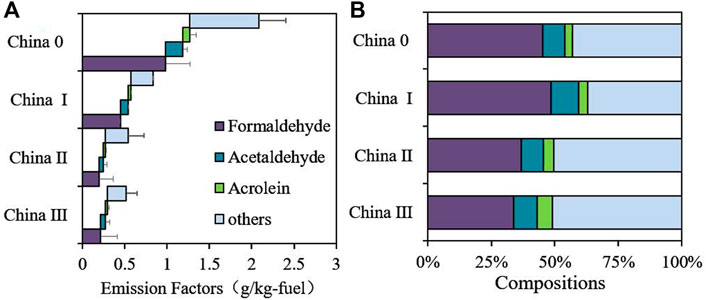
FIGURE 1. Carbonyl compound emission factors (A) and mean compositions (B) for the construction machinery under the different emission standards.
The EF for carbonyl compounds decreased with standard tightening, which is consistent with the trend of EFs for CO, HCs, black carbon (BC) and other pollutants obtained in other studies (Fu et al., 2012; Wu et al., 2022a; Wu et al., 2022b). The EFs for carbonyl compounds of the CⅠ machinery were 59.89% lower than those of the C0 machinery, and the EFs for formaldehyde, acetaldehyde and acrolein of the CⅠ machinery were 54.45%, 52.28% and 63.27% lower, respectively, than those of the C0 machinery. This may occur because the latter emission standard was first implemented, and notable pollution reduction efforts were subsequently implemented. Hence, the pollutant emissions greatly decreased. From CⅠ to CⅡ, the EFs for the total carbonyl compounds, formaldehyde, acetaldehyde and acrolein decreased by 35.66%, 56.72%, 47.52% and 18.60%, respectively. This occurred because to meet the restrictions at the second stage, manufacturers mainly used intercooled and turbocharged diesel engines. These engine types exhibited an improved fuel economy and reduced exhaust gas temperature, thereby lowering the emission of pollutants (Fu et al., 2012).
As shown in Figure 1B, the proportions of formaldehyde and acetaldehyde emitted by the CII and CIII construction machineries were lower than those emitted by the C0 and CI machineries, indicating that formaldehyde and acetaldehyde were more efficiently reduced than acrolein and other carbonyl compounds due to the implementation of new standards and engine technology updates. At present, emission limits of carbonyl compounds are not specified in the emission standards for non-road mobile machinery in China, but our results indicate that with the implementation of stricter CO, HC, NOx and PM standards, the EFs for carbonyl compounds also gradually decreased.
3.1.2 Operating modes
Figure 2 shows the influence of operating modes on carbonyl compound emission factors, fuel consumption and mean compositions for the construction machinery under the different emission standards (CII and CIII) and machinery types (excavator and loader). The EFs for carbonyl compounds under working were higher than moving conditions. The carbonyl compounds EFs under moving condition for CII excavator, CIII excavator, CII loader and CIII loader were 0.51 ± 0.21, 0.48 ± 0.37, 0.43 ± 0.37, 0.45 ± 0.26 g/(kg-fuel), respectively. The carbonyl compounds EFs under working condition were 2%, 32%, 93% and 1% higher than moving condition for CII excavator, CIII excavator, CII loader and CIII loader, respectively. The EFs for formaldehyde, acetaldehyde, acrolein and carbonyl compounds under working conditions were all higher than those under moving conditions, respectively. Construction machinery only moves forward or backward during walking, but it repeatedly performs lifting, falling, overturning, excavation and other actions during working. So the engine load is higher under working condition than walking condition, the fuel consumption increases, but fuel combustion is insufficient, resulting in an increase in emissions under working conditions. The above trend was similar to that of BC, CO, HCs and other pollutants determined in other studies (Fu et al., 2012; Wu et al., 2022b). The proportions of formaldehyde and acetaldehyde under working condition were lower than moving condition for CII and CIII excavator, but were higher than moving condition for CII and CIII loader.
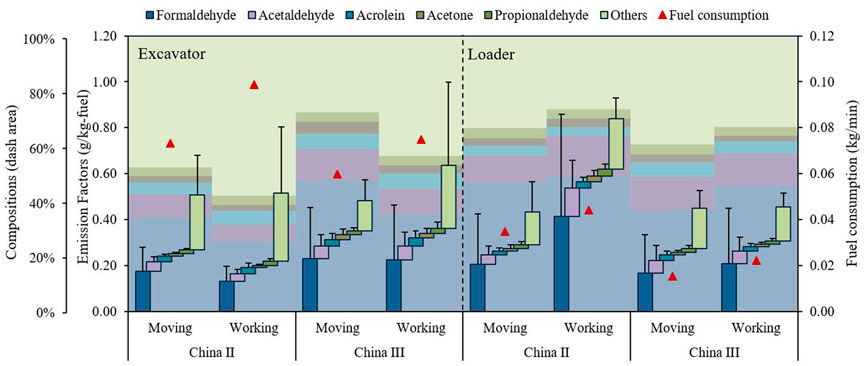
FIGURE 2. The influence of operating modes on carbonyl compound emission factors, fuel consumption and mean compositions for the construction machinery under the different emission standards and machinery types.
3.1.3 Rated power
Due to the limited sample size of wheel loaders, we analyzed the effect of the engine power on the EF for carbonyl compounds of crawler hydraulic excavators under the same emission standard, as shown in Figure 3. In regard to the CⅡ excavator, the EFs for carbonyl compounds at the four power stages of <37 kW, 37–75 kW, 75–130 kW and >130 kW were 0.63, 0.47, 0.67 and 0.17 g/(kg-fuel), respectively, and considering the CⅢ machinery, the EFs at the four power stages were 0.83, 0.76, 0.16 and 0.26 g/(kg-fuel), respectively. In general, the fuel consumption of construction machinery with power greater than 75 kW was higher than that of construction machinery with power less than 75 kW, but the carbonyl compound emissions were lower than those construction machinery with power less than 75 kW. The rated power mainly drove a higher fuel consumption. The working conditions of the construction machinery tested in this study are consistent, and the work done to overcome the resistance should also be consistent, construction machinery with power greater than 75 kW may exhibit a lower engine load than that of construction machinery with power less than 75 kW during working and walking, so the emissions of carbonyl compounds may be lower. However, construction machinery with power less than 75 kW (especially construction machinery with power less than 37 kW) exhibited a higher engine load, so the emissions of carbonyl compounds were higher. In some cases, the EF increased with increasing power, which may occur because some machines exhibited a high rated power, but they are used for a long time, provide a high mechanical quality and lack maintenance, resulting in high EFs.
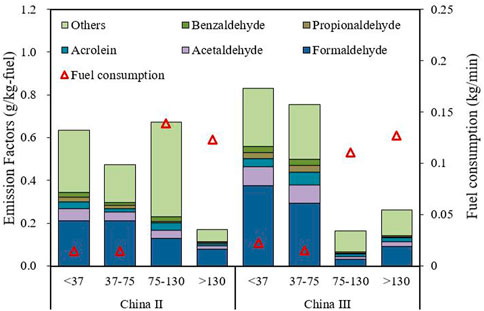
FIGURE 3. Emission factor for carbonyl compounds of excavators under the different engine rated powers.
3.1.4 Mechanical type
Figure 4 shows the influence of the machinery type on the carbonyl compound EFs (Average of working and walking modes) under the same emission standard. The carbonyl compound EFs of wheel loaders and excavators were 0.55 and 0.52 g/(kg-fuel), respectively, for CⅡ and 0.27 and 0.55 g/(kg-fuel), respectively, for CⅢ. The EF of wheel loaders was slightly higher than that of excavators under CⅡ, which is consistent with the CO, HC, NOX and PM emissions measured by Fu et al. (2012) and Frey et al. (2010). There are obvious differences between the driving and operation modes of loaders and excavators, such as moving and using buckets, while the average engine load of wheel loaders is high when they are operated under the working mode, resulting in high emissions (Fu et al., 2012). However, the carbonyl compound EF of excavators was higher than that of loaders under CIII, which is consistent with the BC emissions reported by Wu et al. (2022a). The reason may be that the fuel consumption of CIII excavators is higher than that of wheel loaders due to the higher engine load of these excavators, as shown in Figure 4. The proportions of carbonyl compounds emitted by wheel loaders and excavators obviously differed, but there were no similar trends between the CII and CIII emission standards.
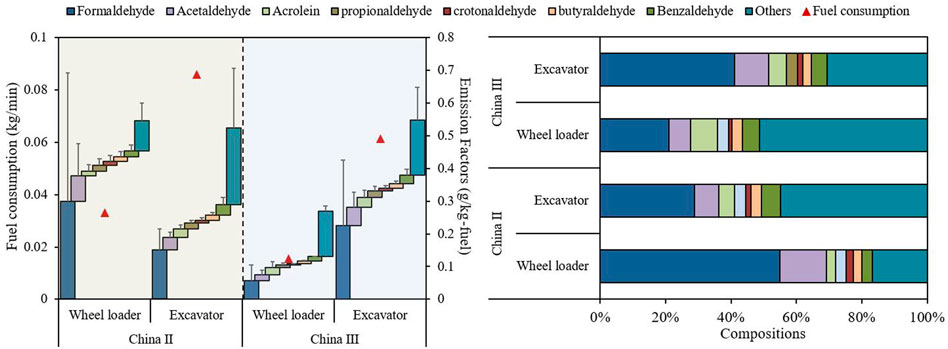
FIGURE 4. Influence of the machinery type on the carbonyl compound emission factors under the different emission standards.
3.1.5 OFPs
Construction machinery may constitute an important source of ozone formation. To estimate the contribution of construction machinery to photochemical ozone generation, the MIR method was used to calculate OFP values. Figure 5A shows the contribution of each component to the OFP under the different emission standards. The OFPs under C0, CⅠ, CⅡ and CⅢ were 13.28 ± 4.27, 5.79, 2.94 ± 2.11 and 2.81 ± 2.35 (g O3)/(kg-fuel), respectively. With the tightening of emission standards, the contribution of each component to the OFP gradually decreased, and the OFPs decreased by 56.4%, 49.2% and 4.4% from C0 to CⅠ, CⅠ to CⅡ, and CⅡ to CⅢ, respectively. Similar to agricultural machinery, formaldehyde was also found to be the main carbonyl compound stemming from construction machinery responsible for ozone formation because of the large amounts emitted and the high MIR value of formaldehyde (Yu et al., 2023). The OFPs of construction machinery are lower than those of agricultural machinery and rural vehicles but higher than those of gasoline and diesel vehicles under the same emission standards (Yu et al., 2023; Zhang et al., 2013; Cao et al., 2016; Cao et al., 2020, Ye, 2014; Yao et al., 2015a; Yao et al., 2015b; Yao et al., 2015c). The reason is the difference in EFs, as described later.
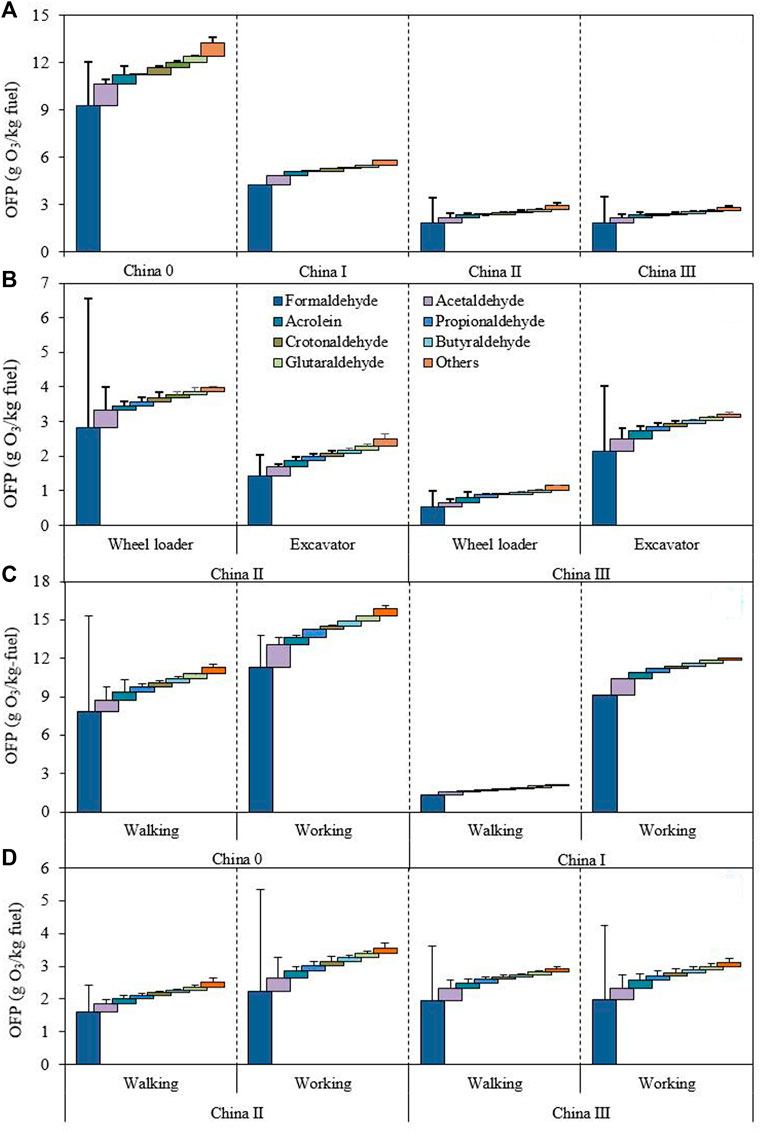
FIGURE 5. Contribution of each component to the OFP under the different emission standards (A), machinery types (B) and working conditions (C,D).
Figure 5B shows the contribution of each component to the OFP under the different vehicle types and emission standards. The contributions of wheel loaders and excavators to the OFP under CⅡ were 3.97 and 2.49 (g O3)/(kg-fuel), respectively, and the contributions of wheel loaders and excavators to the OFP under CⅢ were 1.15 and 3.22 (g O3)/(kg-fuel), respectively. Consistent with the trend of the EFs, the OFPs of wheel loaders were 59% higher than those of excavators under CII, but the OFPs of wheel loaders were 64% lower than those of excavators under CIII.
The OFPs of construction machinery under the different emission standards and working conditions are shown in Figures 5C, D, respectively. In regard to the C0 construction machinery, the OFPs under walking and working conditions were 11.33 ± 10.32 and 15.85 ± 2.54 (g O3)/(kg-fuel), respectively. For the CⅠ construction machinery, the OFPs during walking and working were 2.09 and 11.99 (g O3)/(kg-fuel), respectively. Considering the CⅡ construction machinery, the OFPs under walking and working conditions were 2.51 ± 1.17 and 3.57 ± 4.17 (g O3)/(kg-fuel), respectively. Regarding the CIII construction machinery, the OFPs during walking and working were 2.93 ± 2.11 and 3.12 ± 3.27 (g O3)/(kg-fuel), respectively. The OFPs under working conditions were higher than those under walking conditions considering the different emission standards; the OFPs under working conditions were 1.40, 5.73, 1.42 and 1.07 times those under walking conditions for the C0, CⅠ, CⅡ and CⅢ construction machineries, respectively. Formaldehyde was the species contributing the most to ozone because of its high emissions and high MIR value.
3.2 Comparison to other research
Figure 6 shows the difference in construction machinery carbonyl compound EFs between this and previous studies. There was a slight difference between the pollutant emissions of agricultural and construction machineries. The EFs for carbonyl compounds emitted by the C0, CⅡ, and CⅢ construction machineries were 1.13, 0.86 and 1.25 times, respectively, those emitted by agricultural machinery. In general, the carbonyl compound EF of non-road mobile machinery was 4.5 times that of on-road mobile sources. The EF for carbonyl compounds originating from construction machinery was 9.50 times that for carbonyl compounds originating from gasoline vehicles produced before the first Chinese emission standard (C0) was established, and the emissions of carbonyl compounds originating from construction machinery were 32.03, 27.88 and 21.02 times those originating from gasoline vehicles meeting the CI, CII and CIII emission standards, respectively (Zhang et al., 2013; Cao et al., 2016). Yu et al. (2023), considered that the carbonyl compound EF of construction machinery is higher than that of gasoline vehicles because carbonyl compounds are emitted as a result of incomplete fuel oxidation during combustion, and there are differences in the composition, quality and air/fuel ratio between gasoline and diesel. The carbonyl compound emissions of the CIII construction machinery were 2.24 times those of CIII LDDTs (Ye, 2014; Yao et al., 2015b; Cao et al., 2020). The carbonyl compound emissions of the CIII construction machinery were 2.33 times those of CIII MDDTs (Ye, 2014; Yao et al., 2015b). In addition, under C0, CⅠ, CII and CIII, the emissions of carbonyl compounds of construction machinery were 3.09, 1.88, 2.13 and 2.50 times those of HDDTs, respectively (Ye, 2014; Yao et al., 2015a; 2015b; Cao et al., 2020). This may be due to differences in factors such as the fuel quality, driving cycle, engine technology and exhaust control technology (Yu et al., 2023). The carbonyl compound emissions of the CII construction machinery accounted for 45% of the carbonyl compound emissions of CII rural vehicles. The carbonyl compound emissions of 4-wheel rural vehicles varied between those of the C0 and CI construction machineries, and the carbonyl compound emissions of 3-wheel rural vehicles varied between those of the CI and CII construction machineries.
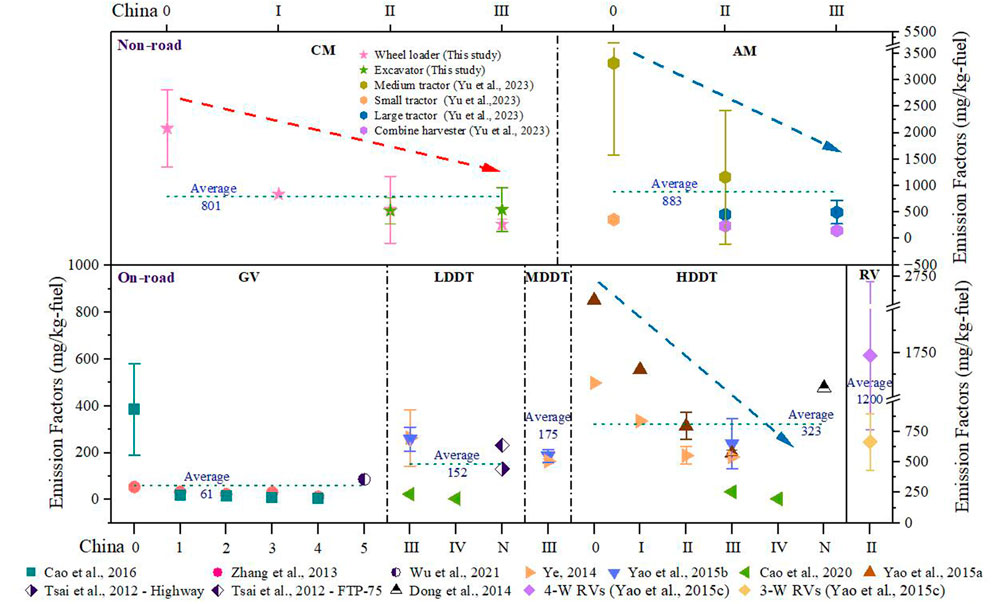
FIGURE 6. Comparison of the carbonyl compound emission factors of construction machinery in this study to those obtamed in previous studies. Note: The carbon balance method is used to convert emission factors based on mileage from other publications into emission factors based on fuel consumption. CM, AM, GV, LDDT, MDDT, HDDT, RV, 3-W, and 4-W denote construction machinery, agricultural machinery, gasoline vehicles, light-duty diesel trucks, medium-duty diesel trucks, heavy-duty diesel trucks, rural vehicles, 3-wheel vehicles, and 4-wheel vehicles, respectively.
4 Conclusion
A total of 21 construction machineries were assessed via a PEMS in the real work process. Offline 2,4-DNPH and HPLC analysis methods were used to evaluate 15 carbonyl compounds emitted by construction machinery, and the MIR method was used to calculate the OFP of carbonyl compounds emitted by construction machinery. The results were compared to carbonyl compound emission and OFP data of other types of vehicles identified in previous studies.
Formaldehyde, acetaldehyde and acrolein accounted for more than 50% of the total carbonyl compound emissions. According to the current emission standards in China, the carbonyl compounds emitted by construction machinery were 9.50–32.03 times and 1.88–3.09 times those emitted by gasoline and diesel vehicles, respectively. We found that the emissions of non-road mobile machinery were 4.5 times those of on-road mobile source vehicles. Compared to other types of vehicles, the amount of carbonyl compounds emitted by construction machinery in the working process was larger, which indicates that more research and control measures for carbonyl compounds emitted by construction machinery are needed in the future. Emission standards and working processes can affect carbonyl compound emissions and OFP. The EFs for carbonyl compounds of the CI construction machinery were 60% lower than those of the C0 construction machinery, 36% lower for the CⅡ machines than those of the CI machines, and 3% lower for the CⅢ machines than those of the CII machines. More carbonyl compounds were emitted in the working process than in the walking process. Under the same emission standard, the EFs decreased with increasing rated power. The EF of CⅡ wheel loaders was higher than that of excavators. However, the EFs of CIII excavators were higher than those of loaders. Formaldehyde was found to be the main carbonyl compound emitted by construction machinery, with the highest OFP value. Carbonyl compounds emitted by construction machinery in China must be further researched.
The OFPs under C0, CⅠ, CⅡ and CⅢ were 13.28 ± 4.27, 5.79, 2.94 ± 2.11 and 2.81 ± 2.35 (g O3)/(kg-fuel), respectively. With the tightening of emission standards, the contribution of each component to the OFP gradually decreased. The OFPs of construction machinery were lower than those of agricultural machinery and rural vehicles but higher than those of gasoline and diesel vehicles under the same emission standards. Consistent with the trend of the EFs, the OFPs of wheel loaders were 59% higher than those of excavators under CII, but the OFPs of wheel loaders were 64% lower than those of excavators under CIII. The OFPs under working conditions were higher than those under walking conditions considering the different emission standards.
In recent years, some Chinese cities have been plagued by O3 pollution. This study obtained the carbonyl compounds EFs data and OFP of construction machinery in the actual working process, which is helpful to improve the accuracy of the carbonyl compounds emission inventory. We found that the implementation of CIII standard did not significantly reduce the emission of carbonyl compounds, the reduction effect of China IV standard implemented on 1 December 2022 also required further research. We found that the tested construction machinery with high rated power generally exhibited lower emissions, and which may reduce the intensity of pollutant emissions while improving work efficiency. Formaldehyde was found to be the main carbonyl compound emitted by construction machinery, with the highest OFP value, the manufacturers should pay more attention to reduce the formaldehyde emission. The carbonyl compound emission and OFPs of construction machinery were higher than those of gasoline and diesel vehicles under the same emission standards. With the strict emission standards implementation of on-road vehicles in China, their pollutant emissions continue to decrease. Thus, pollutant emissions from construction machinery are becoming more prominent as the rapid urbanization in China.
Data availability statement
The raw data supporting the conclusion of this article will be made available by the authors, without undue reservation.
Author contributions
XS: Conceptualization, methodology, writing—Original Draft, writing—Review and editing, visualization, supervision, project administration, funding acquisition. CZ: Writing—Original draft, writing—Review and editing, visualization, formal analysis, investigation. ZY: Conceptualization, methodology, resources, supervision, project administration, funding acquisition. BW: Methodology, resources, project administration. WY: Resources, visualization, formal analysis. XC: Data curation, project administration. XH: Resources, writing—Review and editing. QZ: Data curation, project administration. XL: Project administration. HZ: Data curation.
Funding
This work was funded by the Beijing Natural Science Foundation (8222041, JQ19030), and the National Natural Science Foundation of China (41605095, 41775126).
Conflict of interest
The authors declare that the research was conducted in the absence of any commercial or financial relationships that could be construed as a potential conflict of interest.
Publisher’s note
All claims expressed in this article are solely those of the authors and do not necessarily represent those of their affiliated organizations, or those of the publisher, the editors and the reviewers. Any product that may be evaluated in this article, or claim that may be made by its manufacturer, is not guaranteed or endorsed by the publisher.
References
Ban-Weiss, G., Mclaughlin, J., Harley, A., Kean, J., Grosjean, E., and Grosjean, D. (2008). Carbonyl and nitrogen dioxide emissions from gasoline- and diesel-powered motor vehicles. Environ. Sci. Technol. 42 (11), 3944–3950. doi:10.1021/es8002487
Bie, P., Ji, L., Cui, H., Li, G., Liu, S., Yuan, Y., et al. (2022). A review and evaluation of nonroad diesel mobile machinery emission control in China. J. Environ. Sci. doi:10.1016/j.jes.2021.12.041
Cao, T., Durbin, T. D., Russell, R. L., Cocker, D. R., Scora, G., Maldonado, H., et al. (2016). Evaluations of in-use emission factors from off-road construction equipment. Atmos. Environ. X. 147, 234–245. doi:10.1016/j.atmosenv.2016.09.042
Cao, T., Russell, R., Durbin, T., Cocker, D., Burnette, A., Calavita, J., et al. (2018). Characterization of the emissions impacts of hybrid excavators with a portable emissions measurement system (PEMS)-based methodology. Sci. Total Environ. 635, 112–119. doi:10.1016/j.scitotenv.2018.04.011
Cao, X., Feng, S., Shen, X., Li, X., Yao, X., and Yao, Z. (2020). The effects of biodiesel blends on real-world carbonyl emissions from diesel trucks. Atmos. Environ. X. 238, 117726. doi:10.1016/j.atmosenv.2020.117726
Cao, X., Yao, Z., Shen, X., Ye, Y., and Jiang, X. (2016). On-road emission characteristics of VOCs from light-duty gasoline vehicles in Beijing, China. Atmos. Environ. X. 124, 146–155. doi:10.1016/j.atmosenv.2015.06.019
Caplain, I., Cazier, F., Nouali, H., Mercier, A., Dechaux, J., Nollet, V., et al. (2006). Emissions of unregulated pollutants from European gasoline and diesel passenger cars. Atmos. Environ. X. 40 (31), 5954–5966. doi:10.1016/j.atmosenv.2005.12.049
Carter, W (1994). Development of ozone reactivity scales for volatile organic compounds. Air Waste 44, 881–899. doi:10.1080/1073161X.1994.10467290
Christensen, C. S., Skov, H., and Nielsen, T. (2000). CTemporal variation of carbonyl compound concentrations at a semi-rural site in Denmark. Atmos. Environ. X. 34, 287–296. doi:10.1016/S1352-2310(99)00297-6
Cogliano, V., Baan, R., Straif, K., Grosse, Y., Lauby-Secretan, B., El-Ghissassi, F., et al. (2011). Preventable exposures associated with human cancers. JNCI J. Natl. Cancer Inst. 103 (24), 1827–1839. doi:10.1093/jnci/djr483
Dong, D., Shao, M., Li, Y., Lu, S., Wang, Y., Ji, Z., et al. (2014). Carbonyl emissions from heavy-duty diesel vehicle exhaust in China and the contribution to ozone formation potential. J. Environ. Sci. 26 (1), 122–128. doi:10.1016/S1001-0742(13)60387-3
Duan, J., Tan, J., Yang, L., Wu, S., and Hao, J. (2008). Concentration, sources and ozone formation potential of volatile organic compounds (VOCs) during ozone episode in Beijing. Atmos. Res. 88 (1), 25–35. doi:10.1016/j.atmosres.2007.09.004
Fan, C., Song, C., Lv, G., Wang, G., Zhou, H., and Jing, X. (2018). Evaluation of carbonyl compound emissions from a non-road machinery diesel engine fueled with a methanol/diesel blend. Appl. Therm. Eng. 129, 1382–1391. doi:10.1016/j.applthermaleng.2017.10.086
Fan, W., Jiang, W., Chen, J., Yang, F., Qian, J., and Ye, H. (2023). Exhaust emission inventory of typical construction machinery and its contribution to atmospheric pollutants in Chengdu, China. J. Environ. Sci. 125, 761–773. doi:10.1016/j.jes.2022.02.018
Frey, H., Kim, K., Pang, S., Rasdorf, W., and Lewis, P. (2008). Characterization of Real-World activity, fuel use, and emissions for selected motor graders fueled with petroleum diesel and b20 biodiesel. J. Air Waste Manag. Assoc. 58 (10), 1274–1287. doi:10.3155/1047-3289.58.10.1274
Frey, H., Rasdorf, W., and Lewis, P. (2010). Comprehensive field study of fuel use and emissions of nonroad diesel construction equipment. Transp. Res. Rec. 2158 (2158), 69–76. doi:10.3141/2158-09
Fu, M., Ge, Y., Tan, J., Zeng, T., and Liang, B. (2012). Characteristics of typical non-road machinery emissions in China by using portable emission measurement system. Sci. Total Environ. 437, 437255–437261. doi:10.1016/j.scitotenv.2012.07.095
Guo, X., Wu, H., Chen, D., Ye, Z., Shen, Y., Liu, J., et al. (2020). Estimation and prediction of pollutant emissions from agricultural and construction diesel machinery in the Beijing-Tianjin-Hebei (BTH) region, China. Environ. Pollut. 260, 113973. doi:10.1016/j.envpol.2020.113973
Han, C., Liu, R., Luo, H., Li, G., Ma, S., Chen, J., et al. (2019). Pollution profiles of volatile organic compounds from different urban functional areas in Guangzhou China based on GC/MS and PTR-TOF-MS: Atmospheric environmental implications. Atmos. Environ. X. 214, 116843. doi:10.1016/j.atmosenv.2019.116843
Henning, R., Johnson, G., Coyle, J., and Harbison, D. (2017). Acrolein can cause cardiovascular disease: A review. Cardiovasc. Toxicol. 17 (3), 227–236. doi:10.1007/s12012-016-9396-5
Ho, K. F., Lee, S. C., Louie, P. K. K., and Zou, S. C. (2002). Seasonal variation of carbonyl compound concentrations in urban area of Hong Kong. Atmos. Environ. X. 36 (8), 1259–1265. doi:10.1016/S1352-2310(01)00570-2
Ho, K., Ho, S., Cheng, Y., Lee, S., and Zhen, Y. (2007). Real-world emission factors of fifteen carbonyl compounds measured in a Hong Kong tunnel. Atmos. Environ. X. 41 (8), 1747–1758. doi:10.1016/j.atmosenv.2006.10.027
Ho, K., Ho, S., Huang, R., Dai, W., Cao, J., Tian, L., et al. (2015). Spatiotemporal distribution of carbonyl compounds in China. Environ. Pollut. 197, 316–324. doi:10.1016/j.envpol.2014.11.014
Li, C., Cui, M., Zheng, J., Chen, Y., Liu, J., Ou, J., et al. (2021). Variability in real-world emissions and fuel consumption by diesel construction vehicles and policy implications. Sci. Total Environ. 786, 147256. doi:10.1016/j.scitotenv.2021.147256
Luecken, D., Napelenok, S., Strum, M., Scheffe, R., and Phillips, S. (2018). Sensitivity of ambient atmospheric formaldehyde and ozone to precursor species and source types across the United States. Environ. Sci. Technol. 52 (8), 4668–4675. doi:10.1021/acs.est.7b05509
Ma, S., Zhang, K., Wang, F., Pang, K., Zhu, Y. J., Li, Z., et al. (2018). Characterization of tailpipe emissions from in use excavators. Environ. Sci. 40 (04), 1670–1679. doi:10.13227/j.hjkx.201806224
Mee (2021). China mobile source environmental management annual report. Available at: https://www.mee.gov.cn/hjzl/sthjzk/ydyhjgl/202109/t20210910_920787.shtml (Accessed March 4, 2022).Ministry of ecology and environment of the people’s republic of China)
Nogueira, T., Souza, K., Fornaro, A., Andrade, M., and Carvalho, L. (2015). On-road emissions of carbonyls from vehicles powered by biofuel blends in traffic tunnels in the Metropolitan Area of Sao Paulo, Brazil. Atmos. Environ. X. 108, 88–97. doi:10.1016/j.atmosenv.2015.02.064
Pang, K., Meng, X., Ma, S., and Yin, Z. (2021). Characterization of pollutant emissions from typical material handling equipment using a portable emission measurement system. Atmosphere 12, 598. doi:10.3390/atmos12050598
Pierson, W., Gertler, A., Robinson, N., Sagebiel, J., Zielinska, B., Bishop, G., et al. (1996). Real-world automotive emissions—summary of studies in the Fort McHenry and tuscarora mountain tunnels. Atmos. Environ. X. 30 (12), 2233–2256. doi:10.1016/1352-2310(95)00276-6
Schauer, J., Kleeman, M., Cass, G., and Simoneit, B. (1999). Measurement of emissions from air pollution sources. 2. C1 through C30 organic compounds from medium duty diesel trucks. Environ. Sci. Technol. 33 (10), 1578–1587. doi:10.1021/es980081n
Seco, R., Penuelas, J., and Filella, I. (2007). Short-chain oxygenated VOCs: Emission and uptake by plants and atmospheric sources, sinks, and concentrations. Atmos. Environ. X. 41 (12), 2477–2499. doi:10.1016/j.atmosenv.2006.11.029
Shen, H., Liu, Y., Zhao, M., Li, J., Zhang, Y., Yang, J., et al. (2021a). Significance of carbonyl compounds to photochemical ozone formation in a coastal city (Shantou) in eastern China. Sci. Total Environ. 764, 144031. doi:10.1016/j.scitotenv.2020.144031
Shen, X., Kong, L., Shi, Y., Cao, X., Li, X., Wu, B., et al. (2021b). Multi-type air pollutant emission inventory of non-road mobile sources in China for the period 1990-2017. Aerosol Air Qual. Res. 21 (9), 210003. doi:10.4209/aaqr.210003
Shen, X., Lv, T., Zhang, X., Cao, X., Li, X., Wu, B., et al. (2021d). Real-world emission characteristics of black carbon emitted by on-road China IV and China V diesel trucks. Sci. Total Environ. 799, 149435. doi:10.1016/j.scitotenv.2021.149435
Shen, X., Shi, Y., Kong, L., Cao, X., Li, X., Wu, B., et al. (2021c). Particle number emissions from light-duty gasoline vehicles in Beijing, China. Sci. Total Environ. 773, 145663. doi:10.1016/j.scitotenv.2021.145663
Shen, X., Yao, Z., Huo, H., He, K., Zhang, Y., Liu, H., et al. (2014). PM2.5 emissions from light-duty gasoline vehicles in Beijing, China. Sci. Total Environ. 487, 521–527. doi:10.1016/j.scitotenv.2014.04.059
Shen, X., Zhao, Y., Chen, Z., and Huang, D. (2013). Heterogeneous reactions of volatile organic compounds in the atmosphere. Atmos. Environ. X. 68, 297–314. doi:10.1016/j.atmosenv.2012.11.027
Shen, X., Che, H., Lv, T., Wu, B., Cao, X., and Li, X. (2023). Real-world emission characteristics of semivolatile/intermediate-volatility organic compounds originating from nonroad construction machinery in the working process. Sci. Total Environ 858. doi:10.1016/j.scitotenv.2022.159970
Sindelarova, K., Granier, C., Bouarar, I., Guenther, A., Tilmes, S., Stavrakou, T., et al. (2014). Global data set of biogenic VOC emissions calculated by the MEGAN model over the last 30 years. Atmos. Chem. Phys. 14, 9317–9341. doi:10.5194/acp-14-9317-2014
Tan, D., Tan, J., Peng, D., Fu, M., Zhang, H., Yin, H., et al. (2021). Study on real-world power-based emission factors from typical construction machinery. Sci. Total Environ. 799, 149436. doi:10.1016/j.scitotenv.2021.149436
Tsai, J., Chang, S., and Chiang, H. (2012). Volatile organic compounds from the exhaust of light-duty diesel vehicles. Atmos. Environ. X. 61, 61499–61506. doi:10.1016/j.atmosenv.2012.07.078
Tu, R., Li, T., Meng, C., Chen, J., Sheng, Z., Xie, Y., et al. (2021). Real-world emissions of construction mobile machines and comparison to a non-road emission model. Sci. Total Environ. 771, 145365. doi:10.1016/j.scitotenv.2021.145365
World Health Organization (Who) (2000). Guidelines for air quality. Geneva, Switzerland: World Health Organization.
Wu, B., Wang, W., Yao, Z., Xuan, K., Wu, Z., Shen, X., et al. (2022b). Multi-pollutant emission characteristics of non-road construction equipment based on real-world measurement. Sci. Total Environ. 853, 158601. doi:10.1016/j.scitotenv.2022.158601
Wu, B., Xuan, K., Shen, X., Zhao, Q., Shi, Y., Kong, L., et al. (2022a). Non-negligible emissions of black carbon from non-road construction equipment based on real-world measurements in China. Sci. Total Environ. 806, 151300. doi:10.1016/j.scitotenv.2021.151300
Wu, Z., Zhang, Y., Pei, C., Huang, Z., Wang, Y., Chen, Y., et al. (2021). Real-world emissions of carbonyls from vehicles in an urban tunnel in south China. Atmos. Environ. 258, 118491. doi:10.1016/j.atmosenv.2021.118491
Yao, Z., Jiang, X., Shen, X., Ye, Y., Cao, X., Zhang, Y., et al. (2015a). On-Road emission characteristics of carbonyl compounds for Heavy-Duty diesel trucks. Aerosol Air Qual. Res. 15 (3), 915–925. doi:10.4209/aaqr.2014.10.0261
Yao, Z., Shen, X., Ye, Y., Cao, X., Jiang, X., Zhang, Y., et al. (2015b). On-road emission characteristics of VOCs from diesel trucks in Beijing, China. Atmos. Environ. X. 103, 87–93. doi:10.1016/j.atmosenv.2014.12.028
Yao, Z., Wu, B., Shen, X., Cao, X., Jiang, X., Ye, Y., et al. (2015c). On-road emission characteristics of VOCs from rural vehicles and their ozone formation potential in Beijing, China. Atmos. Environ. X. 105, 10591–10596. doi:10.1016/j.atmosenv.2015.01.054
Ye, Y. (2014). Emission characteristics of volatile organic compounds from diesel vehicles based on portable emission measurement system. Master degree thesis. Beijing, China: Beijing Technology and Business University.
Yu, F., Li, C., Liu, J., Liao, S., Zhu, M., Xie, Y., et al. (2020). Characterization of particulate smoke and the potential chemical fingerprint of non-road construction equipment exhaust emission in China. Sci. Total Environ. 723, 137967. doi:10.1016/j.scitotenv.2020.137967
Yu, W., Shen, X., Wu, B., Kong, L., Xuan, K., Zhao, C., et al. (2023). Real-world emission characteristics of carbonyl compounds from agricultural machines based on a portable emission measurement system. J. Environ. Sci. 124, 124846–124859. doi:10.1016/j.jes.2022.02.031
Zhang, M., Yao, Z., Zhang, Y., Shen, X., Ye, Y., Yi, Y., et al. (2013). Study on emission characteristics of carbonyl compounds from gasoline vehicles. Acta Sci. Circumst. 33, 1376–1381.
Zhang, Q., Yang, L., Ma, C., Zhang, Y., Wu, L., and Mao, H. (2020). Emission characteristics and chemical composition of particulate matter emitted by typical non-road construction machinery. Atmos. Pollut. Res. 11, 679–685. doi:10.1016/j.apr.2019.12.018
Zhang, Y., Wang, X., Wen, S., Herrmann, H., Yang, W., Huang, X., et al. (2016). On-road vehicle emissions of glyoxal and methylglyoxal from tunnel tests in urban Guangzhou, China. Atmos. Environ. X. 127, 12755–12760. doi:10.1016/j.atmosenv.2015.12.017
Keywords: carbonyl compounds, emission characteristics, ozone formation potential, construction machinery, PEMS
Citation: Shen X, Zhao C, Yao Z, Wu B, Yu W, Cao X, Hao X, Zhou Q, Li X and Zhang H (2023) Real-world emissions and ozone formation potential of carbonyl compounds originating from construction machinery based on a portable emission measurement system. Front. Environ. Sci. 10:1078133. doi: 10.3389/fenvs.2022.1078133
Received: 24 October 2022; Accepted: 05 December 2022;
Published: 20 January 2023.
Edited by:
Biwu Chu, Research Center for Eco-environmental Sciences (CAS), ChinaReviewed by:
Mingliang Fu, Chinese Research Academy of Environmental Sciences, ChinaChaoyang Xue, UMR7328 Laboratoire de physique et chimie de l’environnement et de l’Espace (LPC2E), France
Copyright © 2023 Shen, Zhao, Yao, Wu, Yu, Cao, Hao, Zhou, Li and Zhang. This is an open-access article distributed under the terms of the Creative Commons Attribution License (CC BY). The use, distribution or reproduction in other forums is permitted, provided the original author(s) and the copyright owner(s) are credited and that the original publication in this journal is cited, in accordance with accepted academic practice. No use, distribution or reproduction is permitted which does not comply with these terms.
*Correspondence: Zhiliang Yao, eWFvemhsQHRoLmJ0YnUuZWR1LmNu
 Xianbao Shen
Xianbao Shen Cheng Zhao1
Cheng Zhao1 Zhiliang Yao
Zhiliang Yao Bobo Wu
Bobo Wu Wenhan Yu
Wenhan Yu Hanyu Zhang
Hanyu Zhang